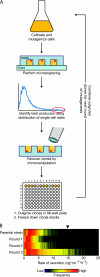Generation and screening of Pichia pastoris strains with enhanced protein production by use of microengraving
- PMID: 21378037
- PMCID: PMC3126391
- DOI: 10.1128/AEM.00104-11
Generation and screening of Pichia pastoris strains with enhanced protein production by use of microengraving
Abstract
The selection of highly productive cell lines remains a key step for manufacturing therapeutic proteins. Microengraving was used to screen chemically mutagenized populations of Pichia pastoris for increased production of an Fc fragment. Clones retrieved following three rounds of mutagenesis yielded titers 2.65-fold greater than those of the parental strain.
Figures


Similar articles
-
Systematic single-cell analysis of Pichia pastoris reveals secretory capacity limits productivity.PLoS One. 2012;7(6):e37915. doi: 10.1371/journal.pone.0037915. Epub 2012 Jun 7. PLoS One. 2012. PMID: 22685548 Free PMC article.
-
Protein secretion in Pichia pastoris and advances in protein production.Appl Microbiol Biotechnol. 2012 Jan;93(1):31-9. doi: 10.1007/s00253-011-3654-z. Epub 2011 Nov 6. Appl Microbiol Biotechnol. 2012. PMID: 22057543 Review.
-
Elimination of N-glycosylation by site mutation further prolongs the half-life of IFN-α/Fc fusion proteins expressed in Pichia pastoris.Microb Cell Fact. 2016 Dec 7;15(1):209. doi: 10.1186/s12934-016-0601-9. Microb Cell Fact. 2016. PMID: 27927205 Free PMC article.
-
[Construction and expression of a fusion protein containing extracellular domain of human Delta-like1 and Fc fragment of human IgG1 in the Pichia pastoris].Xi Bao Yu Fen Zi Mian Yi Xue Za Zhi. 2008 May;24(5):450-2. Xi Bao Yu Fen Zi Mian Yi Xue Za Zhi. 2008. PMID: 18466699 Chinese.
-
Secretory expression of human protein in the Yeast Pichia pastoris by controlled fermentor culture.Recent Pat Biotechnol. 2010 Jun;4(2):153-66. doi: 10.2174/187220810791110679. Recent Pat Biotechnol. 2010. PMID: 20180764 Review.
Cited by
-
Crossword: a fully automated algorithm for the segmentation and quality control of protein microarray images.J Proteome Res. 2014 Feb 7;13(2):362-71. doi: 10.1021/pr401167h. Epub 2014 Jan 24. J Proteome Res. 2014. PMID: 24417579 Free PMC article.
-
Nanowell-based immunoassays for measuring single-cell secretion: characterization of transport and surface binding.Anal Chem. 2014 Dec 2;86(23):11562-9. doi: 10.1021/ac4030297. Epub 2014 Nov 17. Anal Chem. 2014. PMID: 25347613 Free PMC article.
-
Stochastic particle barcoding for single-cell tracking and multiparametric analysis.Small. 2015 Jan 27;11(4):489-98. doi: 10.1002/smll.201401369. Epub 2014 Sep 2. Small. 2015. PMID: 25180800 Free PMC article.
-
Development of Microfluidic Systems Enabling High-Throughput Single-Cell Protein Characterization.Sensors (Basel). 2016 Feb 16;16(2):232. doi: 10.3390/s16020232. Sensors (Basel). 2016. PMID: 26891303 Free PMC article. Review.
-
Biomarkers to evaluate the effects of temperature and methanol on recombinant Pichia pastoris.Braz J Microbiol. 2014 Aug 29;45(2):475-83. doi: 10.1590/s1517-83822014000200014. eCollection 2014. Braz J Microbiol. 2014. PMID: 25242930 Free PMC article.
References
-
- Browne S. M., Al-Rubeai M. 2007. Selection methods for high-producing mammalian cell lines. Trends Biotechnol. 25:425–432 - PubMed
-
- Cereghino J. L., Cregg J. M. 2000. Heterologous protein expression in the methylotrophic yeast Pichia pastoris. FEMS Microbiol. Rev. 24:45–66 - PubMed
-
- Farid S. S. 2007. Process economics of industrial monoclonal antibody manufacture. J. Chromatogr. B Analyt. Technol. Biomed. Life Sci. 848:8–18 - PubMed
-
- Li P. Z., et al. 2007. Expression of recombinant proteins in Pichia pastoris. Appl. Biochem. Biotechnol. 142:105–124 - PubMed
Publication types
MeSH terms
Substances
LinkOut - more resources
Full Text Sources

